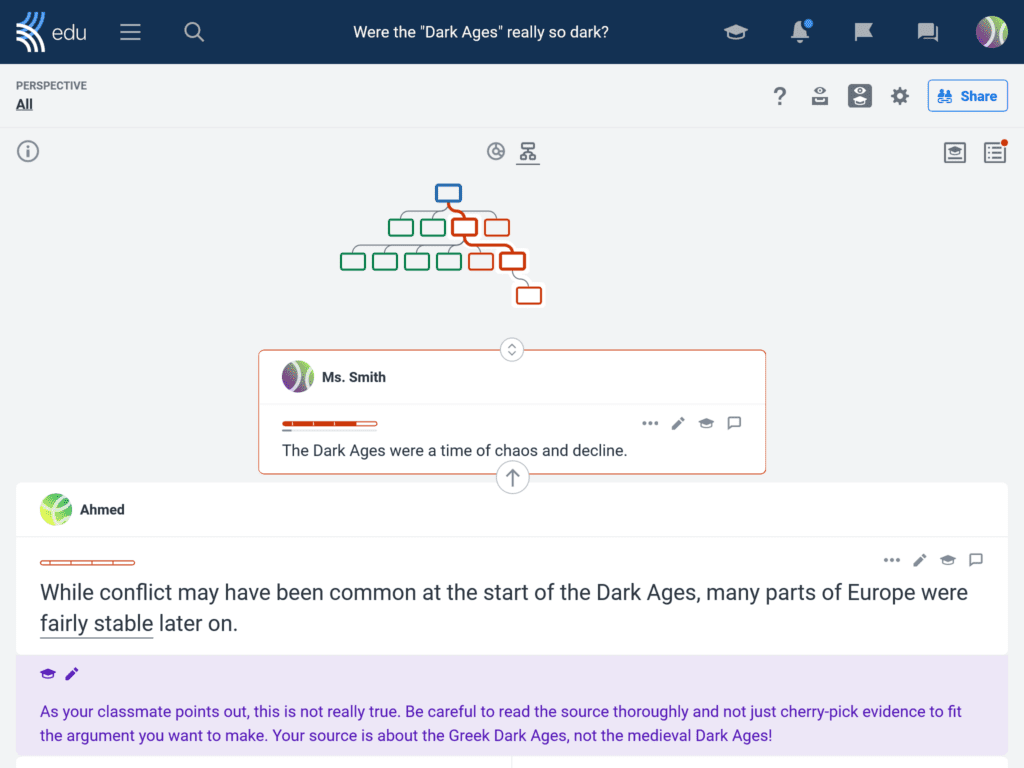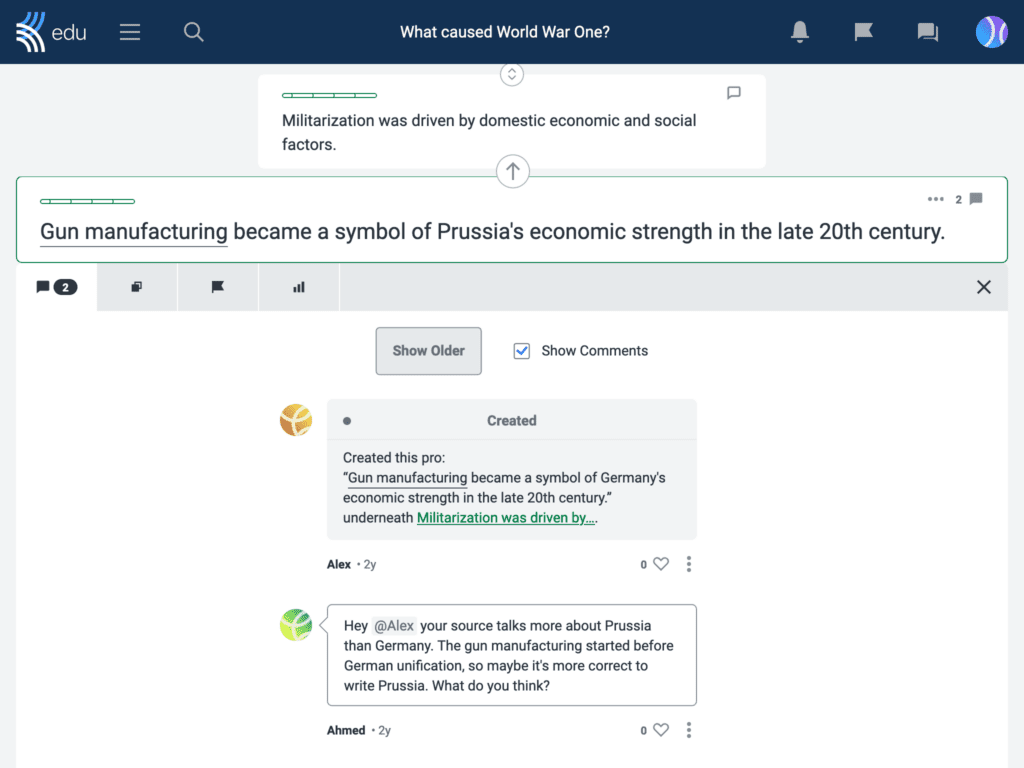Educators can harness the power of effective feedback to improve students’ learning outcomes. And constructive criticism is one approach that can help educators ensure their feedback hits the mark!
So, let’s explore examples of constructive criticism that are ideal for use with students and examine how this method can elevate classroom feedback.
What is constructive criticism?
Constructive criticism is a feedback method where educators target areas for improvement in students’ work, learning, or behavior. For constructive criticism to be considered helpful to students, it needs to embody these three main characteristics:
1. Constructive criticism is specific
Educators identify precise points for students to improve on.
2. Constructive criticism is actionable
Educators give students practical ways to address their points for improvement.
3. Constructive criticism is beneficial to students
Students understand exactly what to improve and the steps they need to take to achieve this, enabling them to progress.
Is constructive criticism considered positive or negative?
Originally, the word “criticism” had a neutral meaning — it simply described the process of making a judgment. However, the word has evolved to sometimes have negative connotations, such as when students criticize the amount of homework they receive.
Thus, if students perceive educator feedback as criticism, they may disengage from the feedback process and miss an opportunity for improvement.
To improve students’ perception of feedback, educators can reframe their advice using the constructive criticism examples featured below. These strategies facilitate educators in giving supportive, meaningful feedback that guides students toward achieving learning goals and outcomes.
Constructive criticism examples: ways to give better feedback to students
Here are some examples of ways you can give constructive criticism to students to help them reach their learning goals.
Use constructive criticism to identify students’ specific points for improvement
Educators can use constructive criticism to pinpoint specific areas for students to target and guide them on how to improve. This is more helpful than vague praise, such as “Well done!” or general comments such as “Improve this section.”
Vague praise could leave students unaware of what exactly they have done correctly or the specific areas they need to improve, resulting in missed learning opportunities.
How to implement this: Use the START (Situation, Task, Action, Result, and Transform) framework
- The START framework helps educators structure constructive criticism to give students a clear understanding of their next steps in learning — and how to tackle them.
- The educator reminds the student of the situation and/or task, identifies the student’s specific action within it, and describes the resulting outcome. This helps pinpoint the student’s exact area for development.
- Then, the educator explains strategies that will enable the student to transform the outcome, making the process constructive.
On Kialo Edu, you can give targeted feedback on every claim that students create, so students understand exactly what they need to improve.

Use constructive criticism to depersonalize feedback to students
Educators can use constructive criticism to emphasize feedback that targets specific work, learning, or behavior, rather than the student personally. This can promote positive and respectful feedback conversations with students, particularly those who sometimes perceive educator feedback as devastating personal criticism.
How to implement this: Use the Third Point method
- In the Third Point method, two people in the feedback conversation, in this case the educator and student, physically focus their attention on the third point. This should be a tangible item like the student’s work, an assessment rubric, or a behavior report.
- Focusing on the third point limits eye contact between the educator and student, which reduces their emotional involvement in the feedback process.
- The student is thus less likely to take the feedback personally and will be more receptive to acting on the educator’s advice.
If you’ve used a Kialo discussion as an activity with your students, consider using its argument map as a tangible third point to focus on when depersonalizing constructive criticism conversations with students.
Use constructive criticism as part of reflective dialogue with students
Educators can use reflective dialogue to encourage students to positively engage with constructive criticism. In these reflective dialogues, students have a space to share their perspectives on learning, with educators adjusting feedback based on the students’ viewpoints. This combats the negativity that students sometimes feel when they view feedback as an imposition that doesn’t consider their opinion.
How to implement this: Use the GROW (Goals, Reality, Options, and Will) framework
- Educators can use The GROW framework to structure constructive criticism during reflective dialogues.
- The educator and student begin by reviewing the learning goal and exploring the student’s current reality. Here, the student shares their perspective.
- The process becomes constructive as the educator and student generate options to help the student achieve the goal.
- They use these options to finalize the student’s next steps and agree on the support the educator will provide.
Use constructive criticism to immediately address students’ misconceptions

Educators can use constructive criticism when teaching content to promptly address students’ learning misconceptions. Students can then take immediate action to improve their learning. This can prevent students from repeating mistakes and embedding misconceptions throughout their work.
How to implement this: Use the Feedforward method
- With the Feedforward method, the educator plays a dynamic role, offering on-the-spot constructive criticism to students during lessons.
- The educator circulates among the class or target group, identifying points for students to address, providing them with constructive support, and monitoring their improvements.
- By the end of the session, students have made progress — and teachers have a bank of evidence ideal for formative assessment.
During a Kialo discussion, you can set feedback for students to appear in real-time for students to consider and implement as they work through their claims.
Train students to use constructive criticism for peer feedback
Training students to give constructive criticism develops their understanding of the feedback process to help each other progress. Moreover, it allows students a perspective into the educator feedback process, which may improve students’ outlook on engaging with the feedback they receive.
How do to implement this: Regularly use peer-to-peer feedback for assignments
- Educators can focus students’ feedback to each other by providing a clear list of success criteria for all tasks.
- You can also give students sentence starters (“Have you considered…?” or “One way you could improve this is…”) to help frame their constructive criticism.
- Following these preparations, students then work in pairs to provide reciprocal constructive criticism and address issues collaboratively.
- During peer conversations, educators monitor and offer support to develop students’ insight into the educator feedback process.
On Kialo Edu, students can give constructive criticism to their peers by leaving comments on claims. Teachers can also add their own comments to support this process, modeling how to leave appropriate constructive criticism.

We hope that our constructive criticism examples for students — and the time-saving tools in Kialo discussions — help you to maximize the benefits of supportive, meaningful feedback in your classroom.
And we practice what we preach here at Kialo Edu, so we’d love to hear your feedback! Head to our Topic Library to start a discussion with your students, and test out our time-saving teacher tools. Send your thoughts to feedback@kialo-edu.com, or post them on any of our social media channels.

